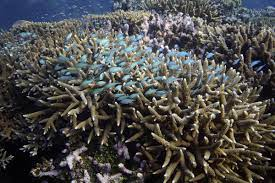Important Facts For Prelims
Black Corals
- 29 Nov 2022
- 7 min read
Why in News?
Recently, some researchers have discovered five new species of Black Corals living as deep as 2,500 feet (762 metres) below the surface in the Great Barrier Reef and Coral Sea off the coast of Australia.
What are Black Corals?
- Black corals (Anthozoa: Antipatharia) can be found growing both in shallow waters and down to depths of over 26,000 feet (8,000 metres), and some individual corals can live for over 4,000 years.
- However, the taxonomy of black corals is poorly known compared to many other anthozoan groups
- Many of these corals are branched and look like feathers, fans or bushes, while others are straight like a whip.
- Unlike their colourful, shallow-water cousins that rely on the sun and photosynthesis for energy, black corals are filter feeders and eat tiny zooplankton that are abundant in deep waters.
- Similarly, to shallow-water corals that build colourful reefs full of fish, black corals act as important habitats where fish and invertebrates feed and hide from predators in what is otherwise a mostly barren sea floor. For example, a single black coral colony researchers collected in 2005 off the coast of California, United States, was home to 2,554 individual invertebrates.
What are Coral Reefs?
- About:
- Corals are marine invertebrates or animals which do not possess a spine. In scientific classification, corals fall under the phylum Cnidaria and the class Anthozoa.
- Coral is made up of genetically identical organisms called polyps. These polyps have microscopic algae called zooxanthellae living within their tissues.
- The corals and algae have a mutualistic relationship.
- The coral provides the zooxanthellae with the compounds necessary for photosynthesis.
- In return, the zooxanthellae supply the coral with organic products of photosynthesis, like carbohydrates, which are utilized by the coral polyps for synthesis of their calcium carbonate skeletons.
- In addition to providing corals with essential nutrients, zooxanthellae are responsible for the unique and beautiful colors of corals.
- They are also called the “rainforests of the seas”.
- Further, they are of two types:
- Hard corals:
- They extract calcium carbonate from seawater to build hard, white coral exoskeletons.
- Hard corals produce a rigid skeleton made of calcium carbonate (CaCO3) in a crystal form called aragonite.
- They are the primary reef-building corals. Hard corals that form reefs are called hermatypic corals.
- Soft Corals:
- Soft coral does not produce a rigid calcium carbonate skeleton and do not form reefs, though they are present in a reef ecosystem.
- Soft corals are also mostly colonial; what appears to be a single large organism is actually a colony of individual polyps combined to form a larger structure. Visually, soft coral colonies tend to resemble trees, bushes, fans, whips, and grasses.
- Hard corals:
- Significance:
- They support over 25% of marine biodiversity even though they take up only 1% of the seafloor.
- The marine life supported by reefs further fuels global fishing industries.
- Besides, coral reef systems generate USD 2.7 trillion in annual economic value through goods and service trade and tourism.
UPSC Civil Services Examination, Previous Year Question (PYQ)
Prelims
Q.1 Which of the following have species that can establish a symbiotic relationship with other organisms? (2021)
- Cnidarians
- Fungi
- Protozoa
Select the correct answer using the code given below.
(a) 1 and 2 only
(b) 2 and 3 only
(c) 1 and 3 only
(d) 1, 2 and 3
Ans: (d)
Exp:
- Symbiosis is a close ecological relationship between the individuals of two (or more) different species.
- The symbiotic association between the invertebrate phylum Cnidaria (Coelenterate) and the unicellular dinoflagellate algae, called zooxanthellae, is very common and symbolises mutualistic interaction. The beautiful colours of coral reefs is due to the different coloured algae symbiotically attached with the coelenterata. Hence, 1 is correct.
- Mycorrhizae are symbiotic relationships that are formed between fungi and plants. The fungi colonize the root system of a host plant, providing increased water and nutrient absorption capabilities while the plant provides the fungus with carbohydrates formed from photosynthesis. Hence, 2 is correct.
- Symbiosis in protozoa mostly represents a close mutualistic association between a protozoan and unicellular symbionts (bacteria, cyanobacteria or/ and unicellular algae) or protozoans and a multicellular organism (ruminants, lower termites, wood-eating cockroaches and plants).
- Termites have a mutualistic relationship with protozoa that live in the insect’s gut. The termite benefits from the ability of bacterial symbionts within the protozoa to digest cellulose. The termite itself cannot do this, and without the protozoa, it would not be able to obtain energy from its food (cellulose from the wood it chews and eats). Hence, 3 is correct.
- Therefore, option (d) is the correct answer.
Q.2 Consider the following statements: (2018)
- Most of the world’s coral reefs are in tropical waters.
- More than one-third of the world’s coral reefs are located in the territories of Australia, Indonesia and Philippines.
- Coral reefs host far more number of animal phyla than those hosted by tropical rainforests.
Which of the statements given above is/are correct?
(a) 1 and 2 only
(b) 3 only
(c) 1 and 3 only
(d) 1, 2 and 3
Ans: (d)
Q.3 Which of the following have coral reefs? (2014)
- Andaman and Nicobar Islands
- Gulf of Kachchh
- Gulf of Mannar
- Sunderbans
Select the correct answer using the code given below:
(a) 1, 2 and 3 only
(b) 2 and 4 only
(c) 1 and 3 only
(d) 1, 2, 3 and 4
Ans: (a)
Mains
Q. Assess the impact of global warming on the coral life system with examples. (2019)







